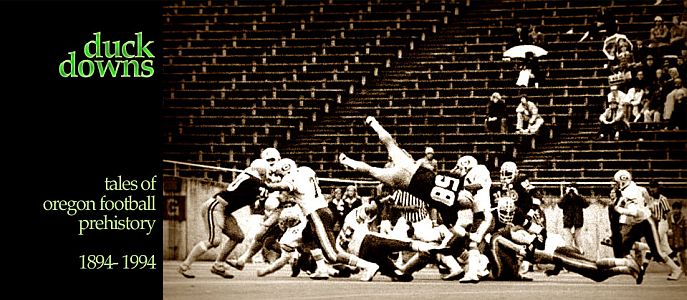« December 1, 1945: OSC at Oregon (Civil War) »
 September 4, 2011
September 4, 2011  click to embiggenThe war is over, and football teams across the country not named Army or Navy are picking up the pieces of shredded rosters and depleted coaching staffs. Some teams soldiered on through the war, and some shut it down. Oregon was one of the latter, OSC the former, and it showed during the 1945 season. A cobbled-together schedule resulted in the only season in which Oregon lost both the Civil War and Border War twice, including this week’s featured program game.
click to embiggenThe war is over, and football teams across the country not named Army or Navy are picking up the pieces of shredded rosters and depleted coaching staffs. Some teams soldiered on through the war, and some shut it down. Oregon was one of the latter, OSC the former, and it showed during the 1945 season. A cobbled-together schedule resulted in the only season in which Oregon lost both the Civil War and Border War twice, including this week’s featured program game.
The Ducks were greener than their home jerseys in 1945. 27 of the 37 roster players were freshmen, and of the “upperclassmen” only Bobby Reynolds held letterman status, having played in ‘42 before joining the Navy. There were four juco transfers, including future standouts Walt Donovan and Jake Leicht. No other player had taken a snap since high school.
That this team managed to win three games says as much about the quality of the opposition — of the three victims, only Cal had fielded a team in 1943 and ‘44, while the losses were all to teams that kept their programs going.
The program has but one color page, the cover, a nice period “guy holding a program with a picture of a guy holding a program with a picture of a guy holding a program…” image of Typical Fan at a bus stop in his stadium coat, by commercial artist William Macrae Gillies. (Don’t get used to these fine-art covers, they’ll be going out of style soon.)
There is solid editorial content in this program — a detailed bio of Duck coach Tex Oliver, and an explanation / apology for the season. Just not much; at 20 pages including covers, the 1945 program is a full 12 pages shorter than that of the 1941 Civil War.
Thankfully, cigarette advertising is down this season. (Don’t get used to that, either.) Just the Chesterfield center roster spread, and the Philip Morris half-page accompanying the explanation of referee signals, and a quarter page for “apple toasted” Old Golds.
On page 4, there’s an In Memoriam placement from the team for their teammate Ronald Crites. Two weeks earlier, Crites, an Army Air Corps pilot, was on a training mission at Mahlon Sweet Field northwest of Eugene when his plane suffered engine failure, caught fire and plummeted to the earth. Crites was killed instantly; his training mate, John Ohmer, died a few days later at Sacred Heart. Investigators never discovered the cause of the crash.
Center spread:


Reader Comments